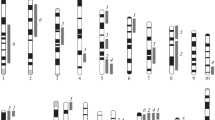Abstract
Significant differences in shock-induced tail rattling, associated with genotype at the albino and agouti loci, were found in crosses between the inbred mouse strains BALB/c and C57BL/6. Using a mutation to albino in the C57BL/6 line, it was shown that the differences in backcross and F2 generations were not due to the pigmentation effects of the coat color loci. It was suggested that a linked locus (i) was responsible for the association between albinism and tail rattling.
Similar content being viewed by others
References
Cavalli, L. L. (1952). An analysis of linkage in quantitative inheritance. In Rieve, E. C. K., and Waddington, C. H. (eds.),Quantitative Inheritance, HMSO London, pp. 135–144.
DeFries, J. C., Hegmann, J. P., and Weir, M. W. (1966). Open-field behavior in mice: Evidence for a major gene effect mediated by the visual system.Science 154:1577–1579.
Fuller, J. L. (1967). Effects of the albino gene upon behavior of mice.Anim. Behav. 15:467–470.
Haber, S. B., and Simmel, E. C. (1976). Tail rattling and agonistic behavior in mice: Coincidental or causal?Bull. Psychon. Soc. 7:84–86.
Henry, K. R., and Schlesinger, K. (1967). Effects of the albino and dilute loci on mouse behavior.J. Comp. Physiol. Psychol. 63:320–323.
Hinde, R. A. (1966).Animal Behavior: A Synthesis of Ethology and Comparative Psychology, McGraw-Hill, New York, pp. 669–670.
Kimbrell, G. McA. (1968). Relationship between shock rate and upright agonistic posture in male and female C57BL/6 mice.J. Sci. Lab. Denison Univ. 49:67–70.
Lagerspetz, K. (1964).Studies on the Aggressive Behavior of Mice, Suoalainen Tiedeakemia, Helsinki.
Mather, K., and Jinks, J. L. (1971).Biometrical Genetics, Cornell University Press, Ithaca, N.Y.
Maynard Smith, J. (1972).On Evolution, Edinburgh University Press, Edinburgh.
Mettälä, R. (1965). A factorial study of the behavior of mice in simulation experiments eliciting aggressive responses.Rep. Inst. Psychol. Univ. Turku 15:1–9.
Morris, D. (1957). “Typical intensity” and its relation to the problem of ritualization.Behaviour 11:1–12.
Petras, M. L. (1967). Studies of natural populations ofMus. III. Coat color polymorphisms and their hearing or breeding structure.Evolution 21:259–274.
Scott, J. P. (1966). Agonistic behavior of mice and rats—A review.Am. Zool. 6:683–701.
Selander, R. K., and Yang, S. Y. (1970). Biochemical genetics and behaviour in wild house mouse populations. In Lindzey, G., and Thiessen, D. D. (eds.),Contributions to Behavior-Genetic Analysis: The Mouse as a Prototype. Appleton-Century-Crofts, New York, pp. 293–334.
Southwick, C. H., and Clark, L. H. (1968). Interstrain differences in aggressive behavior and exploratory activity of inbred mice.Commun. Behav. Biol. 1:49–59.
St. John, R. D. (1973). Genetic analysis of tail rattling in the mouse.Nature 241:549–551.
Tinbergen, N. (1952). “Derived” activities; their causation, biological significance, origin and emancipation during evolution.Quart. Rev. Biol. 27:1–32.
Whitney, G. (1970). Aggression and open field behavior in male mice.Psychon. Sci. 18:167–168.
Author information
Authors and Affiliations
Additional information
This research was supported by NIMH Training Grant MH 11167 while the author was a post-doctoral fellow at the Institute for Behavioral Genetics, University of Colorado, Boulder, Colorado.
Rights and permissions
About this article
Cite this article
John, R.D.S. Major gene effects on shock-induced tail rattling in the mouse. Behav Genet 8, 359–370 (1978). https://doi.org/10.1007/BF01067399
Received:
Accepted:
Issue Date:
DOI: https://doi.org/10.1007/BF01067399




